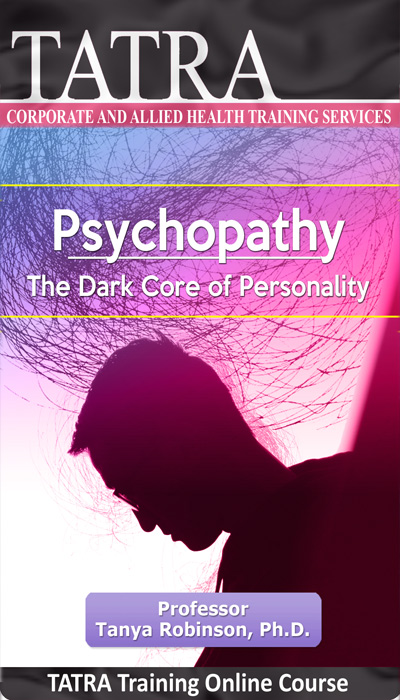14 May Psychopathy: The Dark Core of Personality

Psychopathy can often be misunderstood, and it is important in working with psychopathic clients or cases to have insight on psychopathy, and the dangers associated with psychopathy.
Psychopathy is a personality disorder that has long captured the public imagination. Newspaper articles have been devoted to murderers with psychopathic features, and we also encounter psychopaths in films and books. Individuals with psychopathy are characterised in particular by lack of empathy and guilt, manipulation of other people and, in the case of criminal psychopathy, premeditated violent behaviour. They are dangerous and can incur immeasurable emotional, psychological, physical, and financial costs to their victims and their families.
Despite the public fascination with psychopathy, there is often a very limited understanding of the condition, and several myths about psychopathy abound. For example, people commonly assume that all psychopaths are sadistic serial killers or that all violent and antisocial individuals are psychopaths. Yet, research shows that most psychopaths are not serial killers, and, equally, there are plenty of antisocial and violent offenders who are not psychopaths.
Join Professor Tanya Robinson and learn about the unique features of psychopathy, as well as the impact of the disorder on society as a whole. Psychopathy can often be misunderstood, and it is important in working with psychopathic clients or cases to have insight on psychopathy, and the dangers associated with psychopathy.
This online course will give you an overview of how we can identify individuals with or at risk of developing psychopathy, and how they differ from other people who display antisocial behaviour. Professor Tanya Robinson will also explore the latest genetic, neuroscience, and psychology evidence in order to illuminate why psychopaths behave and develop the way they do, and considers whether it is possible to prevent or even treat psychopathy.
This is not a specialised training unit but a course to provide trainees with a good outline and general understanding of psychopathy as a study field. The unique features of psychopathy, as well as the impact of the disorder on society as a whole, continue to spark interest and fear and will be the focus of the training material.
Insights afforded by the training of psychopathy may provide better understanding of not only fundamental social phenomena like empathy and aggression, but of the basic emotional processes that motivate psychopathic behaviours.
Psychopathy describes a set of personality traits and behaviours frequently associated with lack of emotional sensitivity and empathy, impulsiveness, superficial charm and insensitivity to punishing consequences. These traits and other characteristics will be focussed on in this training module.


Lesson 1 (The Wolf in Sheep’s Clothes Theory):
- discuss why psychopath is a “wolf in sheep’s clothing”.
- list general characteristics and diagnostic features of a psychopath.
- identify diagnostic systems and screening method of psychopathy.
Lesson 2 (Defining Psychopathic Personality and Psychopathy):
- identify psychopathic traits specific to cold heartedness and a callous unconcern for the feeling of others.
- discuss the psychopaths’ shallow emotions, irresponsibility, insincere speech, overconfidence, narrowing of attention, selfishness, inability to plan for the future, emotional pain and violence, source of sadness and self-destruction.
Lesson 3 (The Dark Triad):
- explain the personality traits and characteristics of the Dark Triad (Psychopathy, Machiavellianism, and Narcissism).
- identify sharing qualities between Narcissism, Machiavellianism and Psychopathy.
Lesson 4 (Clinical Criteria – Psychopathy Checklist. Factors and Facets):
- identify the most frequently used and validated diagnostic tool for assessing psychopathy.
- understand the factor structure in the psychopathy checklist (the PCL-R and the PCL:SV).
- explain the four personality dimensions of the Psychopathy Checklist-Revised (PCL-R).
- summarise Hare’s PCL-R items classified according to factors and facets.
- explain the work of Kent Kiehl.
Lesson 5 (The Link: Childhood abuse history and psychotic traits in adult criminal offenders):
- understand the link between early traumatic experiences of abuse/neglect and criminal behaviour.
- explain childhood abuse as a risk factor for the development of externalizing characteristics and disorders including antisocial personality disorder and psychopathy.
Lesson 6 (Female Psychopaths):
- identify that psychopathy has a different progression in men and women regarding both onset and expression.
- explain Forouzan and Cooke’s claims about the differences between the sexes with respect to psychopathy.
- understand that females can be psychopaths and have knowledge on case studies on female psychopaths.
- identify characteristics of female psychopaths and the history of a female psychopath.
Lesson 7 (Male Psychopaths):
- understand the myths around psychopathy and the Hollywood stereotypes.
- explain the weaponized charm of the male psychopath.
- summarise thoughts on the male psychopath being a leader, effortlessly lying, preying on kindness, gaslighting, narcissism, love bombing, characteristics of a chameleon, following cycles of cruelty and kindness, having traumatic pasts, and being empty inside.
- describe case studies on male psychopaths.
Lesson 8 (Psychosis, Psychopathy, and Homicide):
- understand that psychopathy has stood as perhaps the most formidable risk factor for antisocial behaviour, crime, and violence.
- identify that psychopathic traits are a significant risk factor for lethal violence.
- explain psychopathic traits that facilitate horrific crimes and sadistic murders.
Lesson 9 (The successful psychopath):
- have knowledge on a “functional psychopath” and the concept of psychopaths “getting away with murder”.
- explain the corporate psychopath and that not all psychopaths are murderers.
- identify seven characteristics of the modern psychopath.
Lesson 10 (Interesting case studies):
- critically consider the Albert Fish case study.
- explain the work of Neuroscientist James Fallon’s work.


This online workshop will give you instant access to 10 sessions of video content, accessible via streaming on our website, as well as downloadable PowerPoint slides. This course also includes extensive additional reading material, papers and articles.
You can view the course content in your own time, there is no time limit on access.
The duration of this workshop is 9 learning hours. A certificate of completion will be generated upon finishing the course and completing a short multiple-choice assessment test. Please consult your professional organisation/association to confirm whether you are able to claim any CPD points/hours for this online workshop.



 Professor Tanya Robinson majored in social work, psychology, sociology, and criminal justice and has clinical and forensic practice experience. She is a passionate academic and has obtained her 4th PhD in Criminal Justice. Tanya is an Extraordinary Associate Professor (NWU) and an Honorary Research Fellow (KZNU). She takes on Court-appointed work and is a specialist in family assessments and forensic investigations where children are involved. Prof Robinson has worked for many years in Africa and she now operates both in Africa and in South Australia, being the Director and Founder of The Green Duck International Institute. Prof Robinson has been appointed in many Court cases with an international component to facilitate decision-making processes serving the best interests of children. She has vast experience in victimology and specialises in investigating violent crimes committed against children. She is the author and co-authors of various research-based scientific papers and books. She has been in private practice for over two decades.
Professor Tanya Robinson majored in social work, psychology, sociology, and criminal justice and has clinical and forensic practice experience. She is a passionate academic and has obtained her 4th PhD in Criminal Justice. Tanya is an Extraordinary Associate Professor (NWU) and an Honorary Research Fellow (KZNU). She takes on Court-appointed work and is a specialist in family assessments and forensic investigations where children are involved. Prof Robinson has worked for many years in Africa and she now operates both in Africa and in South Australia, being the Director and Founder of The Green Duck International Institute. Prof Robinson has been appointed in many Court cases with an international component to facilitate decision-making processes serving the best interests of children. She has vast experience in victimology and specialises in investigating violent crimes committed against children. She is the author and co-authors of various research-based scientific papers and books. She has been in private practice for over two decades.